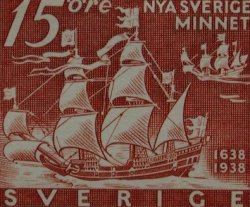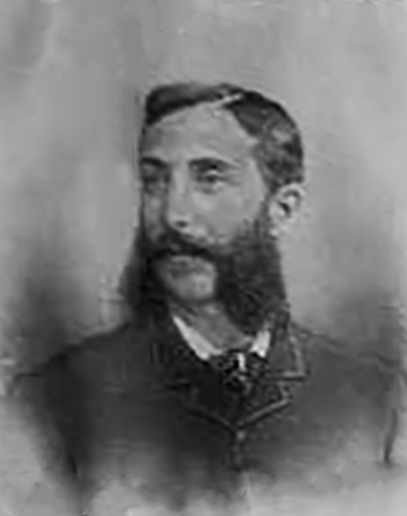Once again, a casual inquiry into local history has morphed into something quite unexpected. The inquiry in question concerns the name given to a Milton-built vessel, the Elizabeth Sinnickson, a three-masted schooner constructed ca. 1867. As with my previous posts on Milton-built ships, the story begins with the shareholders of record, most of whom were Philadelphia natives.
The vessel had an interesting group of shareholders: sixteen in all, each with an equal share. Only two, Noah W. Megee and Joseph C. Atkins, were from Milton, but the fact that Megee was also a noted shipbuilder as well as an investor suggests that it was he who constructed the vessel. One investor, Thomas Gugan of Boston, was probably brought in because of his connections to coal shippers that sought to deliver that fuel to New England. The remaining thirteen shareholders were all Philadelphians, including ship’s master James Winsmore.

Among the Philadelphians, there was a shareholder bloc that would ultimately determine the name of the vessel. Two brothers—John Jacobs Sinnickson and Charles Sinnickson, and their brother-in-law Thomas Yorke, with 3/16 of the shares between them, prevailed in having the ship named after their deceased mother (and mother-in-law) Elizabeth Sinnickson. Although very little information is available about Elizabeth Sinnickson’s life, it is her lineage and that of her husband that took me down a surprising path.
Elizabeth Brinton Jacobs married Thomas Sinnickson in 1810, when they were both about 24 years old. Through this marriage, two unusual family lines—Sinnickson and Jacobs—converged.
The Sinnickson family story is a very interesting one and worth recounting in some detail. By the mid-19th century, the family had been well-established in Salem, New Jersey, since early colonial times. Salem is more familiar to Anglo-centric historians of colonial New Jersey as the center of the Fenwick Colony, a settlement of Quakers that predates the founding of Pennsylvania by seven years. However, the Sinnicksons were Finnish in origin, part of a small population of Swedes, Finns, and English colonists that were settled there well before the Quakers’ arrival.

Formally named New Sweden, a Swedish colony was established in 1638 along the Delaware Bay and River from present-day New Castle to the area that today includes Philadelphia, and included parts of modern Delaware, Pennsylvania, and New Jersey. Established in 1638, New Sweden fell to the Dutch in a bloodless conflict in 1655. The Swedes and Finns were allowed to remain and were granted some measure of autonomy.

Anders Sinnickson, one of the progenitors of the Sinnickson line in the colonies, was born in Sweden in 1651. He arrived in the New World as a child in 1656 on the Mercurius, a Swedish ship, with his father Sinnick Broers[i] and the rest of his family.[ii] It should be noted that Finland was a part of the Kingdom of Sweden at this point, and had been so for centuries. The Mercurius colonists, both ethnic Swedes and Finns, were bound for New Sweden in Delaware, but upon their arrival found that New Sweden no longer existed. They were turned away forcefully by the Dutch commander at New Castle (then called Fort Casimir), but with the aid of local Swedes and their native American allies, the vessel made it to Tinicum Island (in present-day Philadelphia) and unloaded passengers and cargo. Through a complex series of land purchases and migration by his parents, Anders Sinnickson found himself across the Delaware River in the colony of New Jersey, and his descendants gradually migrated to the Salem area. The Finnish and Swedish migration to what is now Salem County in NJ and elsewhere in Delaware and Pennsylvania is commemorated by place names such as Finn’s Point and Swedesboro, both in New Jersey, and the active efforts of the Swedish Colonial Society.

The father of the two Sinnickson shareholders was noted jurist Thomas Sinnickson (1786 – 1873), who served with the U. S. army during the Mexican War and was held several months as a prisoner of war. Thomas was the namesake and nephew of Thomas Sinnickson (1744 – 1817), a captain in the Continental Army and congressman representing N. J. in the U. S. House of Representatives. He is also the great-great-great-grandson of Sinnick Broer the Finn.
Elizabeth Sinnickson (née Elizabeth Brinton Jacobs) was descended from German immigrant John Jacobs, who arrived in the Pennsylvania colony sometime in the late 17th century. German immigrants began arriving in significant numbers in Pennsylvania starting in 1683, partly because of the devastation wrought on their homeland by the Thirty Years War and subsequent conflicts that followed. They were attracted as well by William Penn’s promise of religious tolerance and the availability of land at good prices. Some 65,000 of them arrived in the colonies before the American Revolution, the bulk of them settling in Pennsylvania. They were not a monolithic group; among them were Protestants, Amish, Mennonites, Quakers, and smaller sects, many of whom were escaping religious persecution. The Jacobs family were, in fact, Quakers.
As for the Elizabeth Sinnickson, she enjoyed nearly 14 years of service on both coastal and foreign voyages. She came to grief on August 10, 1881, off Block Island in Long Island Sound, where her hull was stove in by rocks. Cargo and crew were saved, but the ship was condemned.
For further reading
The link http://saltofamerica.com/contents/displayArticle.aspx?0_695 offers a detailed look at competing colonization efforts by the Dutch and Swedes in Delaware, New Jersey and Pennsylvania in the mid-17th century.
Sources
Ships and Men of the Broadkill, by Capt. T. C. Conwell
http://www.njfounders.org/history/1665-founding-salem-fenwick-colony
http://www.genealogia.fi/emi/art/article229e.htm
https://www.geni.com/projects/Mercurius-Passengers-1655/9038
https://archive.org/stream/documentsrelatin37newj/documentsrelatin37newj_djvu.txt
wikipedia.org
[i] Genealogical documents often call him “Sinnick Broers the Finn.”
[ii] The names “Sinnickson” and “Sinnick” have many variants, making the work of genealogists that much more complicated. In addition, the name “Anders Sinnickson,” son of Sinnick Broers, seems to follow an ancient convention that today exists only in Iceland. Needless to say, that convention did not take hold in North America.


So interesting. I am also descended from the Stille/Steelman line from Sweden who settled in that area of New Jersey.
Mary, are you aware of the colonialswedes.net web site and their ongoing efforts to preserve and educate the public on New Sweden’s history? I knew about New Sweden, but not very much, until I started the research for this post.
Very interesting history indeed!
One question in my mind: Where was the shipyard located? I’ve kayaked the Broadkill from Milton to the Delaware river, it doesn’t seem deep enough for a 3 masted schooner size ship. Was the Broadkill deeper at one time?
John, you ask a good question. The Broadkill was once deeper, but has silted up over the last century as river freight traffic became less and less important. Schooners built on the Broadkill had to have a somewhat shallow draft, even when the river was more navigable. That and the narrowness of the river were the two reasons larger ships could not be built in Milton.
The shipyards were located at about the point where the waste treatment plant is currently situated.